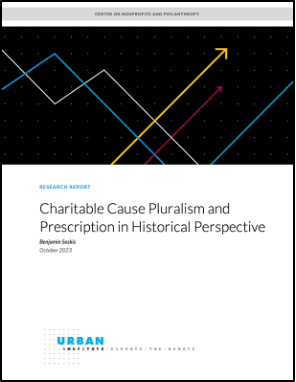The author of a recent Urban institute report comments on the “1 Q: 5 A’s” set of reactions to it.
I very much appreciate the thoughtful responses, pulled together by The Giving Review, to my Urban Institute research report on the history of charitable cause pluralism. I won’t attempt here to address all that was raised by them, but will tease out a few themes or patterns of thinking that resonated especially with me.

The first concerns the relationship between talking about philanthropic or charitable prescription/proscription—that is, activity within the discursive realm—and charitable or philanthropic legislation and/or regulation. As I made clear in my report, the threat of such regulation has long shaped attitudes toward both charitable cause pluralism and prescription, and this is clear within The Giving Review responses as well. There is an implicit (and sometimes explicit) assumption that prescription in the discursive realm will eventually make its way into the legislative realm. Or at the very least, concerns about the dangers of prescription often have fears of regulation at their heart.
There is certainly some cause for the fear—that discursive smoke will lead to regulatory fire—and there has been speculation that it was one of the motivations behind the joint Chronicle of Philanthropy op-ed from foundation leaders defending pluralism. But it’s worth stressing that the fear can also be used in a way to shut down any effort to convince givers that certain causes are more worthy of support than others. I agree with Craig Kennedy that there should be no presumption that donors should be shielded from criticism related to the causes they select—and so one question that the responses raise is how one might engage in discursive charitable or philanthropic prescription without necessarily licensing governmental prescription/proscription.
This question raises another, which was provoked by Jeffrey Cain’s response, and which approaches the prospect of regulation much differently. He writes that “contests over charitable tax regulations are inherent to tax-incentivized charitable giving and unfold with a presumption of pluralism.” Extending this principle further, perhaps we should consider regulatory efforts as themselves expressions of charitable pluralism, as much as donations, whose diversity should be encouraged (in general, if not their actual implementation) in the name of cultivating pluralism. After all, such efforts at reform often speak as much to the holder’s worldview and attitudes regarding the public good as gifts do. Of course, if implemented, some of those policy reforms would limit the giving choices of others. In this case, in what ways would the support of pluralism be useful to adjudicate that clash?
A second theme that emerges from The Giving Review responses is the association between the health of charitable cause pluralism and smaller-scale, everyday giving; another version of the association is that between giving done outside of the bounds of tax-exempt non-profits (or without the claims of tax-deduction) and pluralism. Conversely, there was also an association posed between prescription and larger-scale philanthropy (particularly foundation giving). I think there is some truth here—after all, I did note in my research report that prescriptions that are directed toward large-scale philanthropy are frequently withheld from smaller-scale giving. This seems to have resonated with several of The Giving Reviewers, but I did want to suggest that I think we need to do much more thinking about this dichotomy, noting where it doesn’t necessarily hold (within effective altruism, for instance) and what it says about how different norms seem to apply to different forms of giving.
A third theme—which I will simply gesture toward, but will not attempt to probe more deeply—relates to an understanding of philanthropic pluralism in terms of the depth of views, and not just their variety. Some Giving Review responses raised concerns that the ideological orientation of American philanthropy, in particular its progressive tilt, was a potential challenge to pluralism. But here I wonder about the relation between pluralism and equity. That is, can a philanthropic landscape be described as pluralistic if it exhibits a broad range of views and perspectives—and I think this is undeniably true with respect to the U.S.—even if that diversity isn’t equitably funded, or if some viewpoints have disproportionate power and prestige in certain realms? How exactly is pluralism being invoked in complaints about or defenses of the perceived progressive tilt of the largest foundations?
Finally, I want to end with a question of my own. I discuss in the research report what I believe to be an accommodation that has developed between pluralism and prescription, but I recognize that this might be more of an uneasy truce. I note, for instance, that those prescribing either effective altruism or racial-equity grantmaking often make their cases for their favored approach within the context of an assumption of a diversity of many other causes supported by donors: prescription accommodating to pluralism. But I wonder how champions of pluralism have made accommodations to the growing legitimacy of prescriptive discourse. Have they? Should they? More generally, how do readers understand the current relationship between pluralism and prescription in the discourse surrounding philanthropic and charitable giving?

